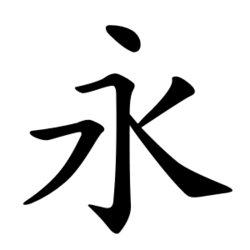永
See also: 氷
| ||||||||
Translingual
| Stroke order | |||
|---|---|---|---|
 | |||
Han character
| Stroke order | |||
|---|---|---|---|
永 (Kangxi radical 85, 水+1, 5 strokes, cangjie input 戈弓水 (INE), four-corner 30232, composition ⿱丶⿲㇇𠃌⿺㇏丿)
Derived characters
References
- KangXi: page 603, character 4
- Dai Kanwa Jiten: character 17088
- Dae Jaweon: page 996, character 4
- Hanyu Da Zidian (first edition): volume 3, page 1546, character 3
- Unihan data for U+6C38
Chinese
| simp. and trad. |
永 | |
|---|---|---|
Glyph origin
Etymology
Uncertain.
- STEDT compares 永 (OC *ɢʷraŋʔ) to provisional Proto-Lolo-Burmese meso-root *ʔ-m(y)aŋ¹/³;
- Bodman (1980) derived 永 (OC *ɢʷraŋʔ) from Proto-Sino-Tibetan *wrjaŋ & considered it cognate with Lepcha hryăn as well as Tibetan རྒྱོང་བ (rgyong ba, “to extend; to stretch”) and རྒྱང་མ (rgyang ma, “distance”);
- Schuessler (2007) considered to be unclear any connection with 泂 (OC *ɡʷeːŋʔ) and Tibetan རིང (ring, “to be tall, long”), Western Tamang rehng pā (“to be long”), Burmese ရှည် (hrany, “to be long”), (all from Proto-Sino-Tibetan *s-r(i/u)ŋ (“to be long, to elongate”)) & Proto-Loloish *s/m-riŋ (“long (adv.)”); so Schuessler compared 永 (OC *ɢʷraŋʔ) to Khmer វែង (vɛɛng, “long”) and Khmer បង្វែង (bɑngvaeng, “to prolong, divert, mislead, deceive”) (both from Proto-Mon-Khmer *waiŋ (“long”)).
Pronunciation
Definitions
永
- perpetual; eternal; permanent; forever
- 投我以木李、報之以瓊玖。匪報也、永以為好也。 [Pre-Classical Chinese, trad.]
- From: The Classic of Poetry, c. 11th – 7th centuries BCE, translated based on James Legge's version
- Tóu wǒ yǐ mùlǐ, bào zhī yǐ qióngjiǔ. Fěi bào yě, yǒng yǐ wèi hǎo yě. [Pinyin]
- There was presented to me a plum, and I returned for it a beautiful jiu gem; not as a return for it, but that our friendship might be lasting.
投我以木李、报之以琼玖。匪报也、永以为好也。 [Pre-Classical Chinese, simp.]
- long (space or time)
- 漢之廣矣、不可泳思。江之永矣、不可方思。 [Pre-Classical Chinese, trad.]
- From: The Classic of Poetry, c. 11th – 7th centuries BCE, translated based on James Legge's version
- Hàn zhī guǎng yǐ, bùkě yǒng sī. Jiāng zhī yǒng yǐ, bùkě fāng sī. [Pinyin]
- The breath of the Han [river] cannot be dived across; the length of the Jiang [river] cannot be navigated with a raft.
汉之广矣、不可泳思。江之永矣、不可方思。 [Pre-Classical Chinese, simp.]
- to prolong; to lengthen
- 皎皎白駒、食我場苗。縶之維之、以永今朝。 [Pre-Classical Chinese, trad.]
- From: The Classic of Poetry, c. 11th – 7th centuries BCE, translated based on James Legge's version
- Jiǎojiǎo báijū, shí wǒ chǎng miáo. Zhí zhī wéi zhī, yǐ yǒng jīncháo. [Pinyin]
- Let the brilliant white colt feed on the young growth of my vegetable garden. Tether it by the foot, tie it by the collar, to prolong this morning.
皎皎白驹、食我场苗。絷之维之、以永今朝。 [Pre-Classical Chinese, simp.]
- 53rd tetragram of the Taixuanjing; "eternity" (𝌺)
- a surname
Compounds
Derived terms from 永
|
|
|
Japanese
Readings
Synonyms
Etymology 1
| Kanji in this term |
|---|
| 永 |
| えい Grade: 5 |
| kan’on |
From Middle Chinese 永 (MC ɦˠwiæŋX).
The kan'on pronunciation, so likely a later borrowing.
Noun
永 • (ei)
- (historical) Abbreviation of 永楽銭 (eirakusen).
- (historical) This term needs a translation to English. Please help out and add a translation, then remove the text
{{rfdef}}.
Etymology 2
| Kanji in this term |
|---|
| 永 |
| よう Grade: 5 |
| goon |
From Middle Chinese 永 (MC ɦˠwiæŋX).
The goon pronunciation, so likely the initial borrowing.
Pronunciation
- IPA(key): [jo̞ː]
Etymology 3
| Kanji in this term |
|---|
| 永 |
| なが Grade: 5 |
| kun’yomi |
| For pronunciation and definitions of 永 – see なが. (This term, 永, is an alternative spelling of the above terms.) |
(The following entry is uncreated: なが.)
Korean
References
Vietnamese
This article is issued from Wiktionary. The text is licensed under Creative Commons - Attribution - Sharealike. Additional terms may apply for the media files.